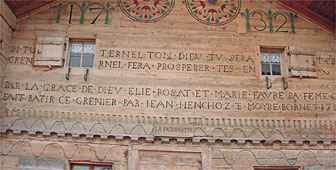
Chalet style in Chateau d’Oex

Tourism has been blamed for the decline of the traditional Swiss chalet. Architecture in many resorts today is a blend of the old and the new.
Examples of the authentic chalets can still be found, some dating back to the 18th century, in the renowned alpine village of Chateau d’Oex.
Unlike many chalets built during the last century, older versions, which were made almost entirely of timber, are easy to distinguish with their carved facades bearing quotations or greetings, in addition to having wide eaves. Their roofs also tend to have unusual “fish scale” patterns thanks to the use of shale tiles.
The La Paquerette is a head-turning example of an old fashioned chalet in Chateau d’Oex, which lies a ten-minute walk uphill from the village’s centre.
The two-storey building is typical of the older chalets found in the Pays-d’Enhaut region, which tend to have larger and more “fancy” exteriors than those found in nearby areas.
“Such chalets are automatically authentic because tourism did not exist at the time,” says Marianne Dubuis, one of the curators of the quaint Vieux Pays-d’Enhaut museum in Château d’Oex.
Folkloric style
She says most authentic chalets date back to pre-1850, and that the style of the facades and the roofs varies from region to region. “Then, the chalet was made for the family. Magnificent chalets were constructed at the time in the folkloric style, but mainly for the pleasure of the owners.”
Dubuis also says that chalets of the Pays d’Enhaut valley tend to be taller and more decorative than those of neighbouring villages because the region was more affluent.
The wealth of the Chateau d’Oex area is often attributed to its rich vegetation and its successful agricultural industry, despite a history of three major fires during the past three centuries that destroyed most of its buildings.
Dubuis attributes the change in the local architectural styles to its history of fires and the influx of European tourists.
Big fire
“The village was dense with chalets (all wooden) and a few houses of the more powerful men of the village, such as the priest,” she reveals. “After the big fire of 1801, new buildings were constructed, which I would call cold or soulless, which also spawned a series of hotels, and a melange of styles.”
The museum is also home to the creations of the renowned “decoupage” artists, Johann Jakob Hauswirth (1809-1871) and Louis David Saugy (1871-1953) – both of whom resided in the Pays-d’Enhaut region.
Dubuis says that decoupage – the art of cutting out whole scenes or elaborate designs in paper and pasting them against a plain background – is designed to tell a story and is displayed in symmetrical halves.
“The process of decoupage must be completed in the head before it is created in reality,” she adds. “Each artist can set his own prices, and like paintings, it is not the ones that are more costly that are necessarily seen as being better. “
The museum also contains exact reconstructions of old chalet kitchens and children’s bedrooms, complete with carved wooden furniture and stained glass windows depicting scenes from the Bible.
A section of the museum is dedicated to the contribution of English visitors to the Lake Geneva region. Among the items on display are a series of watercolours by English artists, a scrapbook on alpine flowers by the botanist, HC Ward, and a book on Switzerland by Elizabeth Strutt.
After all, it was the influx of English tourists, along with the laying of the Montreux-Bernese Oberland rail link, which brought Chateau d’Oex and its cures to the world’s attention.
by MaryAnn Mathew

In compliance with the JTI standards
More: SWI swissinfo.ch certified by the Journalism Trust Initiative




























You can find an overview of ongoing debates with our journalists here . Please join us!
If you want to start a conversation about a topic raised in this article or want to report factual errors, email us at english@swissinfo.ch.